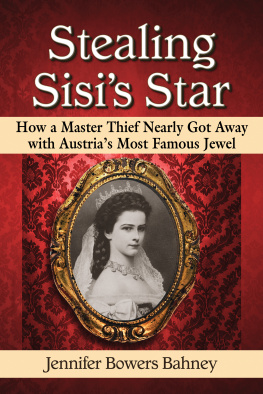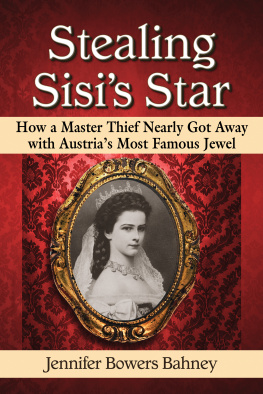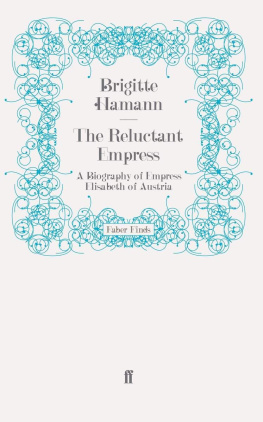Stealing Sisis Star
How a Master Thief Nearly Got Away with Austrias Most Famous Jewel
JENNIFER BOWERS BAHNEY

McFarland & Company, Inc., Publishers
Jefferson, North Carolina
LIBRARY OF CONGRESS CATALOGUING DATA ARE AVAILABLE
BRITISH LIBRARY CATALOGUING DATA ARE AVAILABLE
e-ISBN: 978-1-4766-1939-2
2015 Jennifer Bowers Bahney. All rights reserved
No part of this book may be reproduced or transmitted in any form or by any means, electronic or mechanical, including photocopying or recording, or by any information storage and retrieval system, without permission in writing from the publisher.
On the cover: Nineteenth century postcard depicting Sisi in her coronation regalia as Queen of Hungary, a title she cherished above all others (authors collection)
McFarland & Company, Inc., Publishers
Box 611, Jefferson, North Carolina 28640
www.mcfarlandpub.com
Acknowledgments
I owe a debt of gratitude to the following people for helping this book come to fruition: journalist Joshuah Bearman; Gerald Blanchard and attorney Judith Karfiol; Sergeant Larry Levasseur (retired); Winnipeg Police Superintendent Gordon Schumacher (retired); Terry Kolbuck of the Winnipeg Police Department; attorney Danny Gunn; Jeffrey Oliphant, senior associate chief justice of the Court of Queens Bench of Manitoba (retired); executive assistant to the chief justices and chief judge of the Manitoba courts, Aimee Fortier; manager of provincial court administration for the Winnipeg courts, Elizabeth Dahl; Schnbrunn and Hofburg Palace officials Franz Sattlecker, Josepha Haselbck, Brigitte Wachtl, and Olivia Lichtscheidl; Theatrical Stylist Hannelore Uhrmacher; Nancy Koreen, director of sport promotion for the United States Parachute Association; Martin Kriegel of Kronen Zeitung; Frank Luba of TheProvince; Patricia Dean of the Medill School of Journalism and Annenberg School for Communication; my mother Bette Bowers and my husband Robert H. Bahney, III; my Bahney, Bowers, Ferrante, and Paselsky family members; and all of the wonderful friends who kept me on my toes by continuously asking Hows the book coming? Thank you all.
Preface
The story of Empress Elisabeth of Austria and the theft of the Kchert Diamond Pearl was a match made in heaven for a journalist with a penchant for nineteenth-century European history. I am a firm believer that journalism is the first rough draft of history, a sentiment made popular by publisher Phil Graham, because we journalists usually dont have the time or resources to delve as deeply into a story as we would like before going to print or live on the air. Thus, our work often remains the roughest of rough drafts until a historian comes along and gives a subject the attention it deserves. To thoroughly research a subject for years and spend months writing about it is a luxury I have not had up until now.
I have been fascinated by Empress Elisabeth of Austria since I was a history major at Smith College, when I first learned of her eccentricities and how she manipulated her image to create the legend of a forever youthful and glamorous icon. I read all of the best biographies of Sisi, those by Count Egon Corti, Brigitte Hamann, and Andrew Sinclair, and even the not-so-great biographies by sensationalist or grudge-holding authors who may or may not have known the empress in her lifetime. But I never could bring myself to watch the sugar-coated Sissi [sic] movies from the 1950s, directed by Ernst Marischka and starring Romy Schneider as the perpetually cheerful fairytale empress when I knew how far those romantic comedies veered from the truth.
I found myself wanting to learn the details behind certain facets of Sisis life, like the Franz Xaver Winterhalter painting of the empress with the glittering stars in her hair. What was the full story behind the one image that remains the most famous depiction of this much-painted and photographed woman and that which so completely represented the height of Europes imperial majesty? How did her trademark hair stars come into being, and what happened to them down through the ages? And how could a woman who seemingly had everythingbeauty, riches, a loving familybe so utterly miserable with the fate she had been handed?
One winter morning I was doing a rather routine computer search on Sisi to see if any new research had surfaced, when I stumbled across an April 2010 article for Wired magazine: Art of the Steal: On the Trail of the Worlds Most Ingenious Thief, by journalist Joshuah Bearman, whose exceptional piece on the CIAs foray into the Iran Hostage Crisis was turned into the multiple Oscar-winning film, Argo.
Art of the Steal told the unbelievable story of a Canadian man in his early twenties who used spy tactics to break into Sisis summer residence, Viennas Schnbrunn Palace, and pilfer the last remaining diamond-and-pearl Sisi Star, formally called the Kchert Diamond Pearl, from under the unblinking eye of the museums electronic surveillance system. Searches of Canadian newspaper archives showed that although there were plenty of reports on the crime itself, no one seemed to really understand what the Sisi Star was or who had once owned it; the Star was referred to in more than one piece as a brooch, and Sisi herself was referred to several times by her pre-marriage title of princess. And despite some perfunctory facts, no report ever delved deeper into the rich and tragic history of the Stars original owner.
At that moment, I knew I wanted to tackle the complete story, combining the modern-day crime story with the thoroughly-researched history. I would be weaving together a tale of two narcissists from two very different centuries: the master thief who stole the Kchert Diamond Pearl and Empress Sisi herself. In the case of Sisi, I would have to uncover as much information as I could on this enigmatic woman through her artifacts, poems, and contemporary news clippings. And I had to figure out a way to get in touch with the man who plucked the Sisi Star from the red velvet pillow under the bulletproof glass: Gerald Daniel Blanchard.
I immediately cold-emailed Josh Bearman in the hopes that he might be willing to share a little information on how I could communicate directly with Blanchard. But much to my surprise and delight, Bearman was incredibly generous and supportive. He readily gave me Blanchards contact information, a few words of advice, and an encouraging, Let me know how it goes!
I fired off an email to Blanchard explaining who I was and what my project was about, then waited. And waited. And heard nothing back. After a little digging, I found out that at least one Schnbrunn Palace insider was skeptical of Blanchards story of how he broke into the imperial apartments and how long it took before the theft was discovered. Fingers crossed, I felt this might be the ammunition I needed to get Blanchard to respond to my interview request.
I emailed him again, this time telling him that some in the palace didnt believe he was quite the James Bond character he said he was and that he was the only person on earth who could clear this up for me. Within a day, I had a response, and the next thing I knew I was on the phone with the man who stole the Kchert Diamond Pearl.
In addition to extracting new information from Gerald Blanchard, I also gave him an opportunity to rectify any erroneously reported information on his crime. He corrected the details of one news report in particular but concurred with other accounts, including the Bearman article, one hundred percent. Everything in the article, he told me, I agree. And not only do I agree with it, the Winnipeg Police Service also backed up the credibility of the article. Winnipeg authorities may have confirmed the story of how they investigated and put an end to Blanchards crime spree, but no one but Blanchard himself truly knew how the Sisi Star ended up in his possession.














